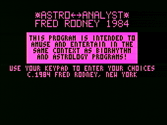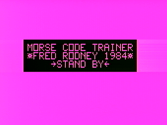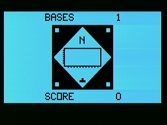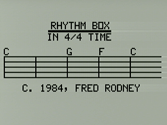






Download digitally archived Bally Arcade tape programs that will load with AstroBASIC (the BASIC with the built-in tape-interface).
 |
"Astro Analyst," 1984 By Fred Rodney. "Astro Analyst" is a one-player game in which the computer will list personality traits (i.e. quiet, logical, sensitive, shy, etc.) based on how you answer the unique program. This computer program is based on an actual psychological exam that presents you with a choice of symbols. The symbols that you select are interpreted by the computer according to the formula programmed into it for doing so, and results in a list of personality traits after all thirteen selections have been made. Paul Thacker notes, "Astro Analyst is along the same lines as WaveMaker's 'Character Analysis,' but with more shapes and less detailed personality descriptions. I don't really get into these, but maybe it's just because it said I was vain and intolerant. :-)" "Astro Analyst" (and the program on the tapes second side, "Memomax") received a positive reviews in "The Game Player" #19 (ARCADIAN 6, no. 8 (Jun. 30, 1984): 77.).
|
| Atlantis |
"Atlantis," 1984. By Fred Rodney. ARCADIAN 6, no. 6 (Apr. 20, 1984): 57. Atlantis, the mythical city that rises above the waves, is under attack by a squadron of ruthless bombers. A bomber flying east, carries a lethal steerable bomb. If the bomb is guided through the city's vulnerable power vent, the above-ground structure explodes and the island's alarm sounds. In a flash, though, the structure is rebuilt. All bombers that pass over the city must return unarmed! It is during this westerly flight that Atlantis can even-up the score by firing a guided missile aimed at destroying the bomber. If the missile is on target, the bomber explodes and the sky flashes brightly. But, alas, a new bomber attacks. When all attacks (turns) are made, the game ends and both scores are displayed continuously. The best score wins... As you tally up the scores, the city of Atlantis survives, as it always has, and always will, high above the "waves.". . . . . Long Live ATLANTIS. "Player 1 defends Atlantis, launches the missiles (trigger) and guides them (joystick score is on the right # of bombers hit. Player 2 attacks Atlantis, releases Bombs (trigger) and guides them (joystick)." Be sure to read short instructions in archive to start the game properly.
|
| Fraction Study |
"Fraction Study." By Fred Rodney. Unpublished May 1984 program submission to the "Arcadian" newsletter. A math tutor program, probably primarily for children. The instructions are in the program and can be called from the keypad. Fraction Tutor only deals with whole numbers, so it is ideally suited her Tiny Basic. Also the large type style of the Astrocade provides for an appealing display that even the younger students can enjoy. Finally, the program is a welcome departure from the usual addition/subtraction tutors.
|
| Gravity |
"Gravity." By Fred Rodney. ARCADIAN 6, no. 5 (Mar. 30, 1984): 41, 42. This Arcadian program was found in the Bob Fabris Collection; it includes a text title screen. Fred mentions in his submission letter that this program was inspired by "Visible Solar System" on the Commodore 64. You command the first fleet of interplanetary space probes. You launch them from aboard your command post on the space shuttle Enterprise. All probes are capable of hovering over any planet at 2000 feet (except Pluto) and each can escape back into space to perform gravitational tests elsewhere. The probes, however, cannot escape from the gravity and heat of the sun. All probes that enter the solar atmosphere for tests will disintegrate, but not before sending you the data you seek. You are left, upon disintegration, with a scene of the night sky from a telescope on your space shuttle. Since you have an unlimited supply of space probes, the disintegration of a few should not concern you. Begin with a probe on Earth, for reference.
|
| Memomax |
"Memomax," 1984 By Fred Rodney. Memomax is played just like "Merlin" and other such games. Use joystick (1) to match the positions and tones displayed after each round. Number of positions and tones increases by one each round. Speed increases by 1/30 of a second to a max speed 1/3 second. Starting speed is 1 second. Paul Thacker notes, "Memomax is a memory game along the lines of Simon, but it's harder because each sequence is completely unique." "Memomax" received a positive review in "The Game Player" #19 (ARCADIAN 6, no. 8 (Jun. 30, 1984): 77.). Special loading instruction note: allow tape to continue playing until the screen turns pink and until after the random musical notes are played (FC will then change in hue).
|
 |
"Morse Code Trainer," 1984 By Fred Rodney. Includes "Morse Code Trainer" and "Morse Code II." These two programs teach how to use Morse code. the instructions contain a "simple oscillator schematic" (based on a 555 timer) that can be used with this trainer. This program incorporates ideas used by the U. S. Navy and by professional code instructors in one self-contained tutor. Side 1 sends code at approximately 15 wpm (words per minute) per character with programmable pauses (speed input). Side 2 sends code at approximately 20 wpm/character. This technique allows for a quick and easy progression to higher speeds. It is highly recommended that a key and an oscillator or a buzzer be used to practice sending code as well.
|
| Planet Mongo! |
"Planet Mongo!." By Fred Rodney. 1984. (Unpublished "Arcadian" newsletter submission.) Planet Mongo has a nuclear waste disposal problem. Within 99 ticks on the clock, 100 points must be played (bonus on 200, 300, etc.). If the clock strikes 0, the planet explodes with complete nuclear meltdown. Cloud layers form, continents collide, the planet spins and breaks apart from the force. Finally, the planet cools and forms a dense globe in space. The satellite, a nuclear waste disposal unit, can still be seen orbiting Planet Mongo and the Game Over" flag appears. Squeeze trigger 1 to replay. With joystick 1 you can move the crosshairs (X=Y/2). Knob 1 controls the rate of movement (Delta X, Delta Y). Move the crosshairs over the satellite to score points. The satellite will move toward your position in a spacecraft beyond the satellites orbit. The satellite will move away (toward the top of the screen) as it completes its orbit. Orbit movement is random but curves are smooth and movement can be predicted. Paul Thacker says, "This is one of the best unpublished Arcadian submissions I've seen. It was submitted late in the Arcadian's lifecycle, so maybe it just got lost in the shuffle. Try to track the satellite's movements with the cursor. Don't aim for where it is; aim for where it's going."
|
 |
"Project Cyclops Radar Base." By Fred Rodney. May 1984. The cyclops is striking at your base. You man the radar, and steer the missile. Miss often and the cyclops will find you, charge, and fire at you! A radar simulation in Astro-Basic 1.8k. Two screens, radar warm-up routine, on screen sweep, varying odds of attack strength, pixel size target and missile, on screen target and missile display. The automatic system is malfunctioning! It can still fire a shell as soon as a cyclops is detected by the radar. All is well except that the automatic guidance control has been hit by a cyclops laser blast. Now it is up to you to steer the shell. You must hit the cyclops in the eye and you must use the radar (they are too far away to see). Use joystick to guide the shell left or right. Paul Thacker notes, "Project Cyclops Radar Base has some good animation, but the gameplay didn't excite me."
|
 |
"Rhythm Box," 1984. By Fred Rodney. Includes Rhythm Box in 3/4 Time and Rhythm Box in 4/4 Time. These two programs create music in different genres. The user can choose from ballads, blues, pop and rock. Rhythm Box was primarily designed as a practice aid for musicians. It can also be used by songwriters for inspiration and by singers.
|
| Video:Video |
"Video:Video." By Fred Rodney. ARCADIAN, 6, no. 11/12 (October 1984): 113. "Video:Video" is a video art program (without sound) that uses four-color graphics on a split screen. When the program is finished (after about 16 minutes), it loops and starts again.
|
